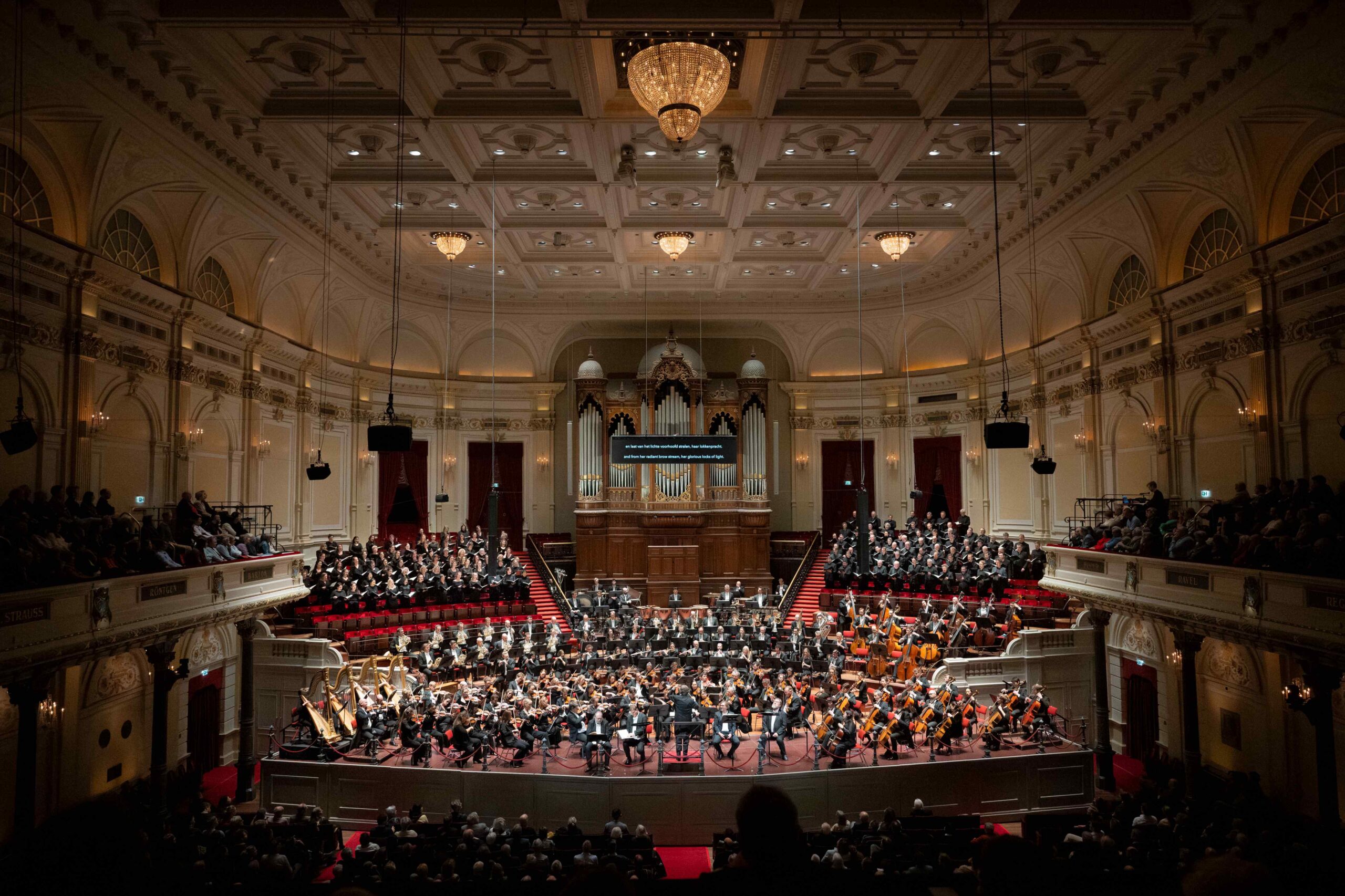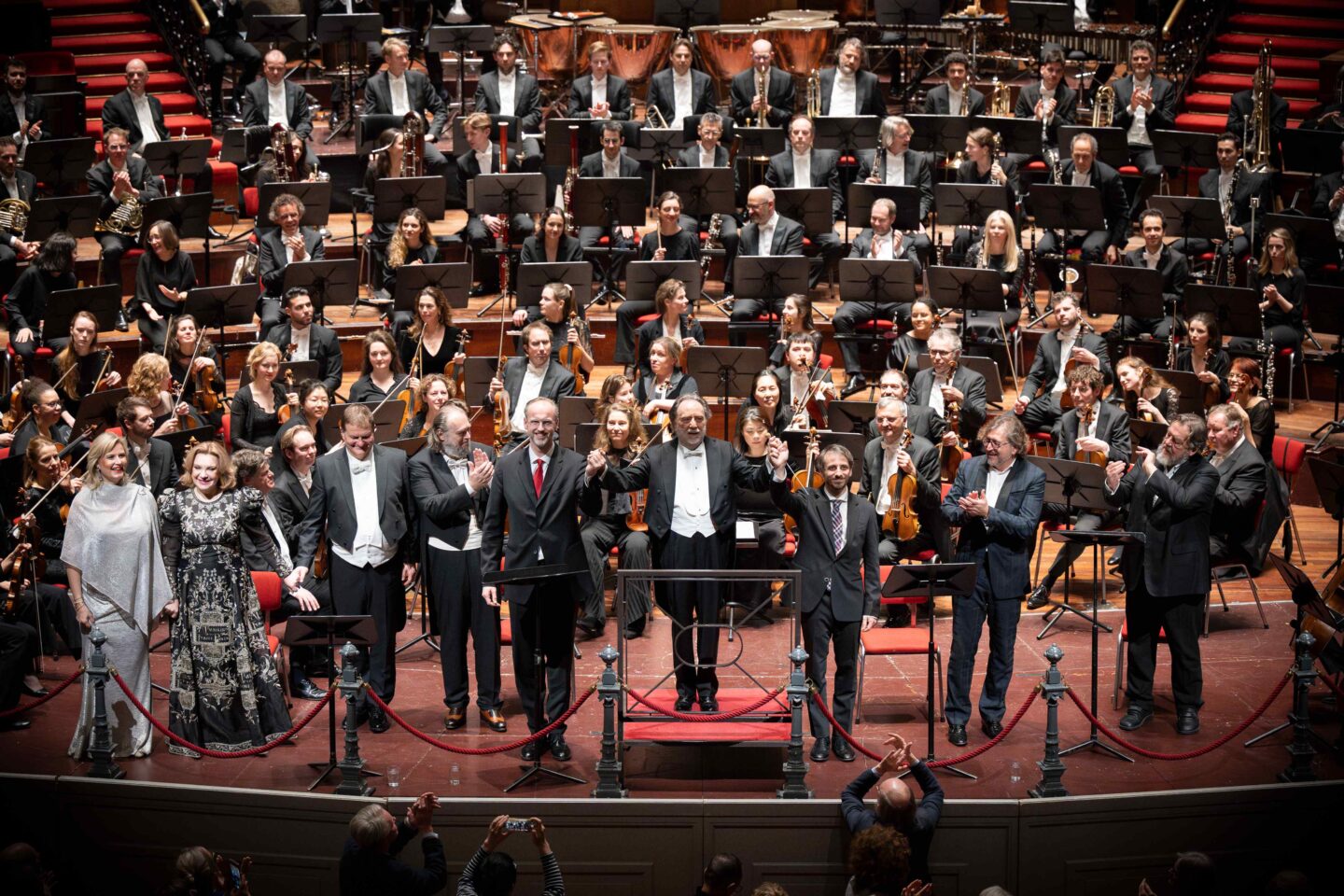“The sensation of these sound waves exhilarates me to the point of swooning” (Anton Webern)
It took 103 years. Surprisingly, more than a century had to pass for the Royal Concertgebouw Orchestra of Amsterdam to perform Schönberg’s Gurre-Lieder again. This means that neither Mengelberg, Haitink, Chailly, nor Jansons had conducted this colossal work during their respective tenures: not a single recording or concert! In March 1921, it was the composer himself who was at the podium for its Amsterdam premiere. Franz Schreker had conducted the first performance in Vienna on February 23, 1913. At that time, Schönberg was disillusioned by the style and character of the piece and even indifferent to its positive reception, saying: “I was rather indifferent, even a little angry. I anticipated that this success would have no influence on the fate of my later works.” He tempered his judgment later in a letter to Kandinsky: “I certainly do not despise this work, as journalists always suppose. For although I have evolved a lot since that time, I have not improved, but my style has simply become more polished… I consider it important that people believe in the elements of this work that I have retained afterward.”
Needless to say, the rebirth – or resurrection – of these Gurre-Lieder at the beginning of February 2024 is of a simply historic nature. Indeed, the work has a reputation for being very difficult, it demands an orchestra beyond all praise, exceptional singers, a substantial choral contingent, but it is not unplayable. The event coincides with the 150th anniversary of the composer’s birth and brings together a luxurious vocal cast: Andreas Schager, Camilla Nylund, Ekaterina Semenchuk, among others, and the Bavarian Radio Chorus, conducted by Riccardo Chailly, conductor emeritus, visibly moved to rejoin the orchestra of which he was the principal conductor between 1988 and 2004 and which recorded an almost absolute reference1. Will this historic event also mark the history of the work’s interpretation? Expectations were exceeded, as we shall judge.
The Gurre-Lieder (Songs of Gurre) form a three-part oratorio, performed by five vocal soloists, a narrator, three choirs, and a large orchestra. This work, initially started as a lieder cycle for soprano, tenor, and piano, was composed by the then Austrian composer between 1900 and 1903. After a break, Schönberg resumed the orchestration in 1910 and completed it in November 1911. The work sets to music the cycle of poems Gurresange by Danish novelist Jens Peter Jacobsen (translated from Danish to German by Robert Franz Arnold). Gurre Castle, located in Denmark, and its surroundings serve as the setting for the plot, which revolves around a medieval love tragedy described in Jacobsen’s poems. The story tells the legend of King Valdemar Atterdag’s (Valdemar IV, 1320-1375, in German Waldemar) love for his mistress Tove, and her murder by Valdemar’s jealous wife, Queen Helvig of Schleswig—a legend that, historically, would be more associated with his ancestor Valdemar I. Schönberg captures the essence of the legend in three unequal parts: the first, an extension of the Tristan chromaticism, a love duet between Waldemar and Tove, then the announcement of Tove’s death, murdered by Waldemar’s wife, the second part, Waldemar’s lamentation, then the third, where Waldemar, after succumbing to despair and sacrilege, is doomed to an endless ghostly quest, before an evocation of the awakening of nature. The composition reflects this frenzied ride and the angst it induces, with moments of raw power like the summer wind sweeping everything in its path. However, Schönberg also weaves a thread of hope through these dark scenes, culminating in a soothing where nature itself seems to heal and be reborn, perhaps reflecting the ultimate catharsis of humanity itself.
The Gurre-Lieder are generally considered the composer’s most significant tonal work, alongside Transfigured Night (Verklärte Nacht); it is often described as post-romantic, lyrical, bombastic, capable of pleasing the Viennese public of 1913, but it contains ambiguous elements, experiments, and daring that must be highlighted, all fascinating elements that evolve between the first and last part, creating a direct transition to atonality, strikingly following the path pursued by Kandinsky in painting at the same time. This work, a veritable laboratory of a new musical style, was fully highlighted by the illustrious Amsterdam ensemble. It will be difficult here to exhaustively pay tribute to this concert, as wonderful moments succeeded miracles and the enchanting spells of a lush score.
The Miraculous Shimmering of the Prelude
The prelude, very much in the style of Debussy and Ravel (we navigate between “La Mer” and the dawn of Daphnis, symbolist, and not impressionist as is often mistakenly believed), is a shimmering, a dusting of sparkling light dispersed by strings already in levitation, emerging from an orchestra whose technical limitations are imperceptible and whose poetry is infinite. Accents from Zemlinsky’s “Die Seejungfrau” (The Mermaid), the teacher of Schönberg, emerge here and there in their characteristic syrupy Viennese sinuosity, but already we feel guided towards another musical world, by an orchestra whose richness and sensuality are damnably seductive. One thinks of the words sung by the soprano in Schönberg’s String Quartet No. 2, which set to music the words of Stefan George: ‘I feel the air of other planets, the ground gives way, I glide over the last cloud’: in this journey to the gates of the supernatural, this unsettling ascent to an unheard harmony of the spheres, the orchestra, in weightlessness, offers a kaleidoscopic sound odyssey adorned with indescribable colors, in unexplored musical dimensions, where expression crosses the borders of the unknown to touch the ineffable. The tone is set: the evening was going to be memorable.
“From the ‘4th act’ of Tristan to the tonal ambiguities of Erwartung
The love duet that follows the prelude is as much a nod to Mahler’s “Das Klagende Lied”2 as to the oppressive heat of Tristan. Andreas Schager (Waldemar), experienced with this work3, sings with conviction and stamina, his voice sometimes a little forced in the high notes. His timbre recalls Jon Vickers in its valor and René Kollo in its color. He indisputably possesses the range of the specific Heldentenor required, between Wagner’s Tristan and Strauss’s Emperor from “Die Frau ohne Schatten”. Camilla Nylund (Tove) seems somewhat more reserved, but she delivers an exceptionally honorable vocal performance, with a notably orgasmic climax when the lovers’ kiss is evoked4; however, it is somewhat unfortunate that the two singers were separated by the podium, as this first part of the Gurrelieder expresses passion, the rise of desire, almost in waves, it is a long love song, voluptuous, with passionate sea spray, with orchestral colors that are obviously derived from Wagnerian chromaticism but with an even more refined, Straussian writing, which even a certain Puccini would not have disdained for the unfinished finale of Turandot. The unmistakable imprint of Gustav Mahler and Richard Strauss is perceived, with a post-romantic palette and a strong tonal structure. The composition ventures into chromatic meanderings and harmonic layers that subtly transform, in response to the richness of the instrumental colors. Strings and winds are simply magical.
The genius of Riccardo Chailly’s direction is palpable at every moment, as he successfully squares the circle in such a complex work5: the analysis, the revelation of the details of the score, in its slightest inflections, with attention to every section, and the spirit, the intelligence, the height of vision, and a vision: in this, he recalls so much Abbado… We are far, very far from the clichés that sometimes surround this work described as “overblown”, “gigantic”. No: it is as much a musical synthesis as a synesthetic experience, the very one that Baudelaire speaks of, the culmination of the Gesamtkunstwerk6 envisioned by Wagner. After such a peak, the intervention of Ekaterina Semenchuk as Waldtaube (the Wood Dove, evoking the death of Tove), is sardonically and wishfully perfect, with controlled lows and a full-bodied depth. Her tragic declamation, without artifice or affectation, dark, sober, and powerful, with highly expressive inflections, will mark, among other moments, this evening. It is there that little by little the music becomes more disturbing, at the end of the first part, heralding the new ways of the future: Chailly marks with scrupulous attention the anguished reliefs of a music that seems to mark the dissolution of reason into venomous sonorities. The second part, very brief, Waldemar’s heartrending song reacting to the death of Tove, is a model of vocal holding as much as of emotion: Andreas Schager is ideal, he is felt to be perfectly at ease in Wagnerian roles, and his interpretation is profoundly sensitive, embodied, and correct.
“Wie ein Naturlaut”7 (“Like a sound of nature”)
Carried by very somber Wagnerian tubas (with very perceptible echoes of both “Die Walküre” and “Götterdämmerung”), the prelude to the third part is fascinating for more than one reason: the orchestra, as perfect as ever, evokes the awakening of specters who soon launch into a race to the abyss, reminiscent of Berlioz in their ghostly roughness. Nothing is heavy; everything is fine, chiseled. The tonality disintegrates, reflecting the psychic universe of Waldemar, lost in a tragic pursuit. Wolfgang Koch, bass, as the peasant, is ideal in his grating evocation of the awakening of spirits. It is striking to note the symbolism at work in this passage: these revenants are to be taken metaphorically, as indicated by Riccardo Chailly’s direction: this music is indeed literally haunted by the specters of a rich but cumbersome musical past, they return, hunt, creak, and whirl in the mind of the composer, who eventually buries them to assert his own style. The intervention of the Bavarian Radio Choir is spectacular: power, diction, epic breath, poetry, everything is perfect, captivating. The buffoon Klaus, carried by a Wolfgang Ablinger-Sperrhacke also very committed, commenting with mocking cynicism, not without recalling Mime, the madness of the king, heralding the wanderings of “Erwartung,” in music that manages to explore the limits of reason, on the borders of tonality. What strength in the words of the choir singing “Die Zeit ist um!” (The time is up!), always from a metamusic perspective, as if the composer himself commented, both resolved and terrified, on his new creation, his new language, like the non-figurative expressionist forms of Kandinsky swimming in the space of a sonic canvas with the dimensions of the Universe.
The final intervention of the Narrator and the end of the work (“The Infernal Hunt of the Summer Wind”) undoubtedly represent the climax of this memorable evening: Robert Hall fulfills his role very honorably in this passage, generally entrusted to veterans of the Wagnerian genre (we still remember Franz Masura, 92 years old, in 2016, with Philippe Jordan), even if he is sometimes slightly covered by the orchestra, to depict this nature that awakens, worked by a sap that only asks to spring forth: it is impossible not to think again of Schoenberg’s musical audacities when the Narrator says: “Sieh! nun ist auch das vorbei” (See! now that too is past!). The miraculously transparent flutes create a detailed, precise painting, reminiscent of Dürer’s naturalist studies as much as the crystalline hues of Ravel’s “L’Enfant et les Sortilèges,” it is a rustle in the grass, a sonorous world teeming with granular siliceous details, aesthetic dysharmonies, that charm and fascinate the listener, immersed at the dawn of a new musical continent. We truly hear “Sprechgesang”8 very controlled, where insects, spiders, frogs, butterflies, a whole world both near and distant, connected to the salvific and invigorating summer wind, suggested by cellos suffocating with beauty. When the final chorus “Seht die Sonne farbenfroh am Himmelssaum” explodes (“”See the sun colorful at the edge of the sky”), we touch the ineffable, in a fervent conclusion, where the singers, conductor, and musicians seem transfigured by a mystical egregore, an apotheosis that now paves the way for all the artistic revolutions of the 20th century, an illumination in the form of an Apollonian triumph, an optimistic victory, where art, once again, prevails over the shadows.
After such a triumphant execution, we can only think, with emotion, of the shock experienced by the listeners in the same temple of Amsterdam music in 1923: a fascinating revolutionary work, like a new artistic ideal, which could entirely be contained in the sublime title of Giovanni Segantini’s painting that influenced Schoenberg’s Quartet of 1905: “Werden – Sein – Vergehen” (Becoming – Being – Passing Away), a symbol of transition where the old gives way to the new in an eternal cycle of creation and transformation, illuminated by a new triumphant sun, the new dawn succeeding the Twilight of the Gods: a new music was born. Among the Celts, “Imbolc” was a festival that marked the celebration of the return of light, the hope of the first rays of a regenerated and vivifying sun: it is no coincidence that, at the beginning of February, Riccardo Chailly, his prestigious phalanx and his superhuman choirs were gathered to celebrate this other rite of spring.
Philippe Rosset
February 1st, 2024
1 Riccardo Chailly, Radio Symphony Orchestra Berlin, Siegfried Jerusalem (Waldemar), Susan Dunn (Tove), Brigitte Fassbaender (Wood Dove), Hermann Becht (Peasant), Peter Haage (Klaus the Jester), Hans Hotter (Narrator), Choir of St. Hedwig’s Cathedral Berlin, Municipal Music Society, Düsseldorf. Decca 473 728-2 (1985). There are, of course, other notable recordings, including Ozawa’s with the Boston Symphony Orchestra, featuring a luxurious vocal cast.
2 This is a profane cantata with mixed choir by Mahler, premiered in 1901
3 Andreas Schager had previously performed as Waldemar in 2016 in Paris under the baton of Philippe Jordan.
4 So laß uns die goldene
Schale leeren
ihm, dem mächtig verschönenden Tod.
Denn wir gehn zu Grab
wie ein Lächeln,
ersterbend im seligen Kuß.
“So let us empty the golden chalice to him, the mightily beautifying death. For we go to the grave like a smile, expiring in a blessed kiss.”
5 For the anecdote, it’s worth mentioning that Schoenberg commissioned a special music paper with 48 staves!
6 The concept of Gesamtkunstwerk, or “total work of art,” is closely associated with the aesthetic of Richard Wagner, who sought to unify all the performing arts—music, poetry, dance, visual art, and staging—into a complete theatrical experience. This holistic approach has influenced many composers, including Arnold Schoenberg, whose Gurrelieder can be seen as an extension of this tradition, merging complex chromatic density with profound textual expression to create an immersive experience that transcends traditional boundaries of music.
7 The indication on the score of Gustav Mahler’s First Symphony “Titan” is obviously not innocent.
8 Sprechgesang is a vocal technique that lies between singing and spoken word. It is characterized by delivering the musical text in a style close to speech, but with precise control over pitch (tone) and rhythm according to musical notation.



